April 2024
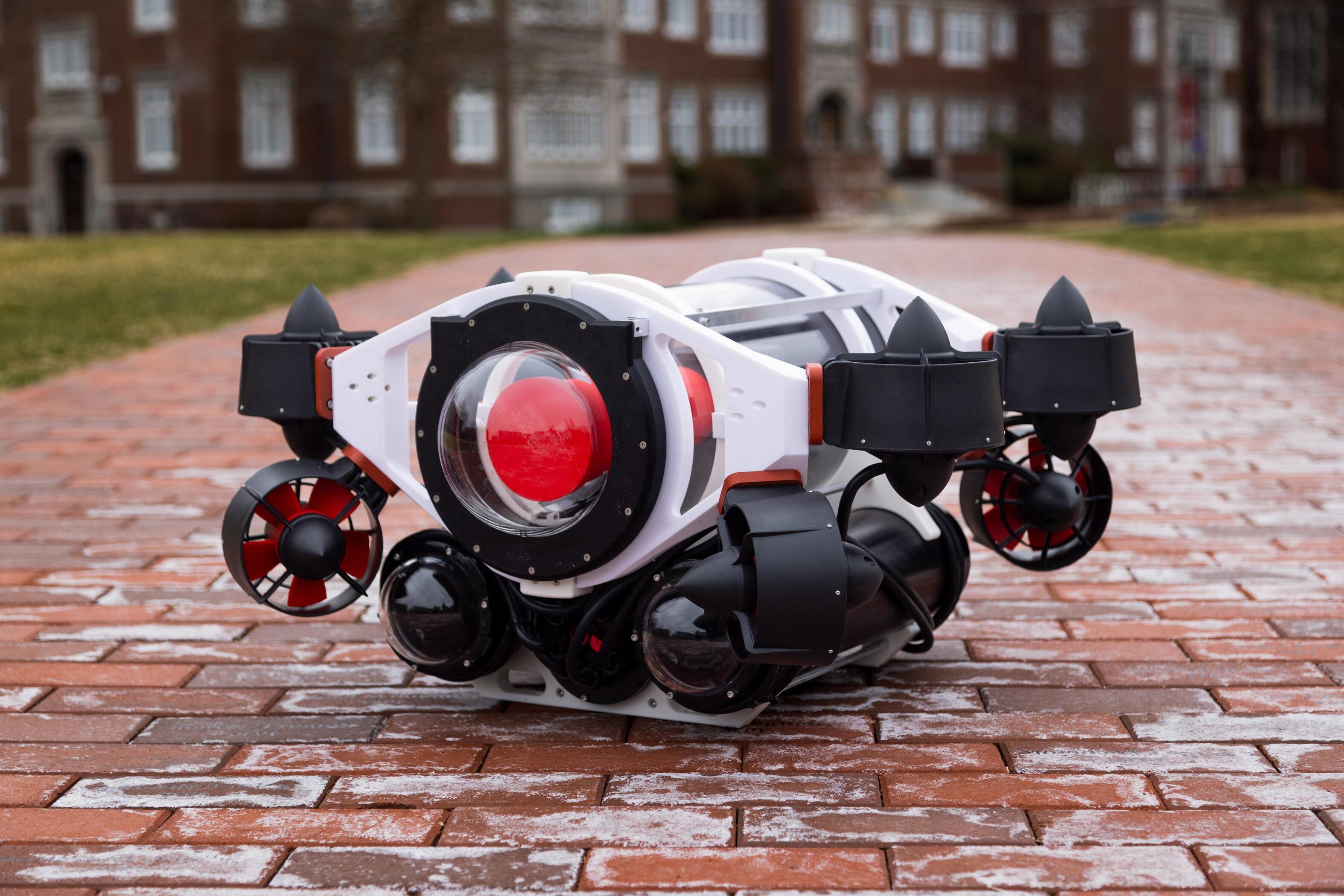

Robotics Engineering Undergraduate Research Projects Showcase
The Department of Robotics Engineering is pleased to showcase the following Major Qualifying Project initiatives as integral components of the 2024 Undergraduate Research Project Showcase.
1
Table of Contents
Advancing Humanoid Robots: Demonstration of Standing and Assisted Walking Alongside a New Simulation Framework
Augmented Reality Human-Robot Interface for Assisting Robotic Manipulation
Automated Control of External Ventricular Drain for Neuro-ICU
Automated Flying Disc Inventory, v2.0
BiQu: Bimodal Quadruped Robot
BranchBot: Autonomous Quadcopter for Branch Attachment
Cube Swarm
6-7 8-9 10-11 12-13 14-15 16-17 18-19 2
Design and Prototyping of a Low-Cost & Efficient Ocean Cleanup Robot
Design and Assembly of a 3D Printed Humanoid Robot for At-Home Assistive Care
EVE- Agricultural Harvesting Robotic System
FASTR – Flexible Articulating Surgical Transoral Robot
HURON: Full-size Humanoid Robot (Lower Body)
Intracardiac Catheter Steering System
LEMUR: Learning and Education of Machine Learning for Undergraduate Robotics
20-21 22-23 24-25 26-27 28-29 30-31 32-33 3
Table of Contents
Multi-Robot Persistent Coverage Under Fuel and Stochastic Failure Constraints
Modular Hybrid Flux Motor Development for High Torque Robotics Applications
NASA Lunabotics '23-'24
Progressive Molding of Soft Robots for Ocean Conservation
SailBot 2023-24
Social Robot for Interactive Play
Soft Assistive Robotics for Helping Daily Tasks
34-35 36-37 38-39 40-41 42-43 44-45 46-47 4
48-49 50-51 52-53 54-55 56-57 58-59 5 Underwater Filmography Using Robots Voice Control of a Hand Exoskeleton for Traumatic Brain Injury Patients with Motor Impairments and Aphasic Speech Waste Sorting Robot for Recycling Trashbot: Autonomous Trach Collecting Robot Symbiotic Multi-Agent Construction 5.0 SOPHT: Soft Prosthetic Hand
Advancing Humanoid Robots: Demonstration of Standing and Assisted Walking Alongside a New Simulation Framework
Team Memebrs
Dylan Nguyen
Stephen Fanning
Jack Rothenberg
Scott Pena
Ana Roure
Jatin Kohli
Advisors
Pradeep
Radhakrishnan
Dirk Albrecht

6
Abstract
This project is a continuation of the multi-year 3Dprinted humanoid robotics MQP aiming to iterate on the simulation, electrical, and firmware solutions of previous years to create a robust, reliable, and efficient open-source humanoid robot. Ava is the current iteration of this robot. Her electrical system was updated to remove points of failure commonly found in moving wiring solutions through the development of a central circuit board and custom wires. The simulation, in CoppeliaSim, was updated to include a more accurate model of the robot along with material and mechanical properties. In simulation, Ava is now capable of unassisted standing, squatting, and walking with a cart. The real-world application of Ava utilizes high-level software through a Raspberry Pi and low-level controls through an Arduino to interact with the world. Using a 9-DOF IMU and trajectory planning with kinematics, she demonstrates walking forward while pushing a cart and standing upright independently.
7
Augmented Reality Human-Robot Interface for Assisting Robotic Manipulation
Team Members Advisors
Tyler Giroux
Dimitri Saliba
Justin Kyi Bryon Tom Alexander Sun
Jane Li Koksal Mus

8
Abstract
Robot autonomy has imprecision both in perception and action. Human assistance can correct this inaccuracy by teaching a robot to make corrective adjustments. The Microsoft HoloLens 2 is an Augmented Reality headset which allows users to view and manipulate holograms in three dimensions, which is well suited for intuitive Human Robot Interaction. However, its tracking capabilities are poorly tailored for fine robot control. Our team proposes a human robot collaborative workspace, as well as a collection of AR Human Robot Interfaces designed to facilitate human assisted robotic manipulation. In addition, we designed a compound manipulation and perception task showcasing our proposed platform to assist robot autonomy and propose a user study to evaluate its efficacy.
9
Automated Control of External Ventricular Drain for Neuro-ICU
Team Members Advisor

10
Matthew Duncan Haotian Liu
Yujie Guo Haoran Zhang
Christopher Nycz
In the complex and critical field of neurocritical care, managing patients who suffer from conditions such as traumatic brain injury (TBI), subarachnoid hemorrhage (SAH), and other related neurological disorders is a challenging endeavor. A fundamental aspect of this management involves the use of external ventricular drains (EVDs) to divert excess cerebrospinal fluid" (CSF) - a key step in alleviating the detrimental effects of these conditions. Through the management of CSF, EVDs monitor and control intracranial pressure (ICP), which is vital for the patient's recovery and for assessing the patient's neurological health. The ICP is set by physically leveling the EVD with a reference point (Kocher's point) on the patient's head. However, in the current setting, it needs frequent re-leveling due to patient movements, leading to constant intervention by hospital staff and disruption for the patient. Our project, Auto-EVD, improves the accuracy of ICP measurements and control. Our system provides real-time alerts to caregivers when changes occur, demonstrates accurate head motion tracking of targeted patients, and automatically levels the EVD. This ensures automated alignment regardless of patient movement, which minimizes staff intervention and enhances patient comfort. The device fits well into current workflows, allowing for easy integration, and provides caregivers with advanced options to deliver specific, individualized care to their patients.
11
Abstract
Automated Flying Disc Inventory
Team Members Advisors
Benjamin Antupit
Jonathan Whooley
Daniel Ouellette
David Costa
Tristan Andrew
Matthew Adam
Claire Higginson
Greg Lewin
Walter Towner

12
Abstract
Maple Hill Disc Golf is a world-class disc golf organization, featuring a premier course and a reputable on-site pro-shop. To reach more customers in the community, Maple Hill intends to establish an online store; however, disc golfers traditionally prefer to purchase discs through physical examination of their features. Therefore, the team has constructed the second iteration of an automated machine that measures these features and inventories them. The machine implements modular design principles to record, maintain, and store information about each disc including the diameter, wing width, flexibility, weight, height, while also taking cosmetic photos. With this automated machine, Maple Hill aims to provide customers with comprehensive product information in order to replicate a traditional in-store shopping experience.
13
Bimodal Quadruped Robot (BiQu)
Team Memebrs
Ethan Chandler
Akshay Jaitly
Yifu Yuan
Puen Xu
Lehong Wang
Tao Zou
Advisors
Mahdi Agheli
Jing Xiao
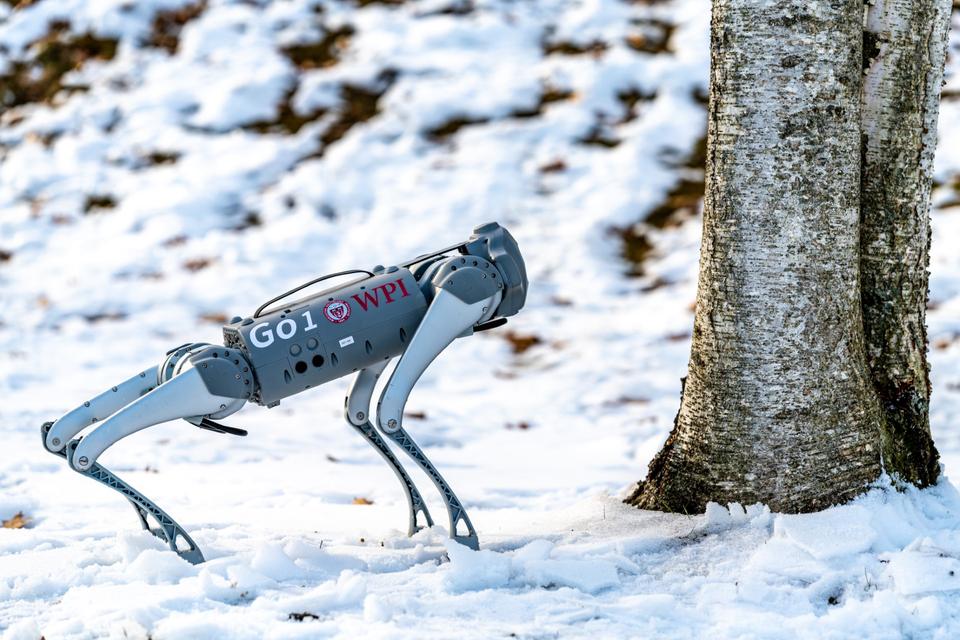
14
Abstract
In the growing field of legged robotics, the integration of locomotion and manipulation locomanipulation poses a significant challenge, addressed by leading organizations such as Boston Dynamics, Tesla, and Unitree. This work presents an open-source framework that facilitates planning through contact, enhancing robots’ capabilities in logistics, construction, and even planetary exploration. Our approach leverages a versatile trajectory optimization method and real-time perception to generate dynamic motions, coordinated through whole-body control. We validate our framework’s effectiveness on the Unitree Go1 equipped with a custom arm, demonstrating its application across various gaits and jumping maneuvers, as well as in simulated environments on humanoid robots like HURON and Atlas. The results showcase the framework’s potential in enabling complex athletic tasks and manipulation while navigating diverse terrains.
15
Team Memebrs
BranchBot: Autonomous Quadcopter for Branch Attachment Advisors
Zane Altheimer
Keelan Boyle
Cooper Dean Andrew Kerekon
Andre Rosendo
Dmitry Korkin
Oren Mangoubi
Robert Krueger

16
Abstract
According to the United States Environmental Protection Agency, pollinators are responsible for assisting 90% of all flowering plant reproduction. However, the effects of climate change and human development have caused their habitats to decline in recent decades. Technology such as robotic bees could be used to supplement pollination efforts, but they require a mobile pollination base station. To address this, we designed a quadcopter with an underactuated grasping mechanism, custom flight software, and a depth-based vision model to identify and perch on tree branches. Our approach allows for autonomous mobile pollination in hard-to-reach locations, ensuring that natural pollinator populations have the ability to rebound.
17
Cube Swarm
Team Memebrs
William Albert
Phillip Brush
Benjamin Dodge
Timothy Klein
Andrew McCammon
Jason Rockmael
Dang Tran
Advisors
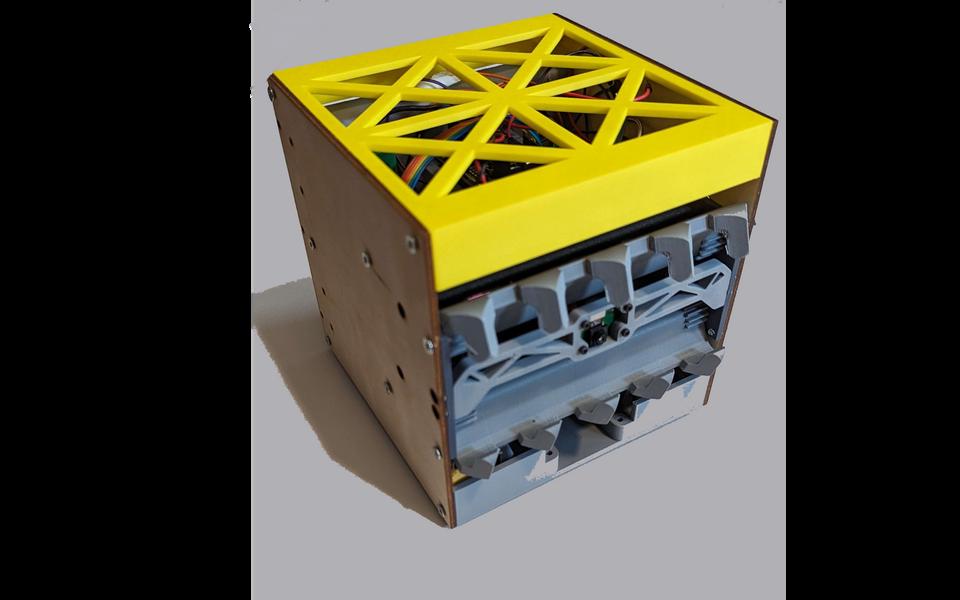
Gregory Lewin
Shubbhi Taneja
Reinhold Ludwig
18
Abstract
Current search and rescue robots suffer from being either too large to fit into tight spaces or too small to traverse terrain. To overcome this challenge, we developed a swarm of interlocking cube-shaped robots that allow robots to explore individually and traverse obstacles via coalescence. We have demonstrated our solution by using a centralized Bluetooth communication network, AprilTag localization, and an efficient path planning algorithm for our robots to explore an arena, then assemble to bridge a gap.
19
Design and Prototyping of a Low-Cost & Efficient Ocean Cleanup Robot
Team Members
Gabriel Espinosa
Danny Ngo
Sebastian Valle
Alexander Wadsworth
Advisors
Selcuk Guceri
Vincent Aloi

20
Abstract
11 million metric tons of trash enter Earth’s oceans each year, contributing to ecosystem loss, wildlife endangerment, and microplastic infiltration within the food supply. Over the past 2 decades, public awareness of the growing threat has increased, resulting in numerous organizations, like The Ocean Cleanup, seeking to curb the problem with their large-scale sweeping tugboats. However, all current efforts are costly, require large crews, and rely on diesel-powered vessels for collection and transport. Our team sought to decarbonize and automate cleanup by developing an efficient robotic platform for open ocean surface trawling. Prototypes of 2 seaworthy, inexpensive, and autonomous-capable robots were developed to tow nets for cleanup in the turbulent open ocean. The robots were designed to operate without human crews and use just 512 watts per kilogram of trash collected, 10 times less than existing systems. Future efforts may focus on commercializing the platform by selling oceanic data collected by onboard sensors.
21
Design and Assembly of a 3D Printed Humanoid Robot for At-Home Assistive Care
Team Members
Shivank Gupta
Anna McCusker
William Michels
Merel Sutherland
Advisors
Pradeep
Radhakrishnan
Dirk Albrecht
Derren Rosbach

22
Abstract
The population of U.S. residents above the age of 85 is expected to double within the next twelve years alongside the growing shortage of at-home assistive health care workers. This project aims to aid assistive care workers in performing simple at-home tasks. Finley, the humanoid robot, has been upgraded from the previous 3D printed humanoid robot MQPs and is now capable of pick-and-place and speech-to-text interaction with humans. Our open-source design also features a modular wrist connection system allowing for hands to be easily swapped without human intervention. Finley showcases this with a versatile two finger gripper which utilizes one rigid and one flexible finger. In addition, our team has redesigned Finley to reduce the number of 3D printed parts and fasteners. These changes have reduced assembly time and improved customizability for Finley. Human trust in robots was also studied to measure the perception of humanoid robots in nursing homes.
23
EVE - AgriculturalHarvesting Robotic System
Team Members Advisors
Soumaya El Mansouri
Lexi Krzywicki
Timothy Rinaldi
Berk Calli
Sarah Wodin-Schwartz
Yarkin Doroz

24
Abstract
The Eve MQP aims to minimize the time between harvest and packaging by bringing the apple grading process onto the field. Conventional methods require bringing apples into a facility after harvesting for grading, increasing time and decreasing freshness. The Eve system efficiently sorts and classifies apples based color and surface defects. Leveraging machine learning, cameras, and sensors, Eve optimizes apple production by reducing labor and reducing human error. Through collaborative efforts, the team designed, prototyped, and refined the Eve Sorting System within an academic year. By automating sorting and lessening manual labor, Eve promises heightened productivity and waste reduction, thereby setting new standards for agricultural automation.
25
Team Members
Chase
Beausoleil
Mark Gagliardi
Samay Govani
Cole Parks
Advisors
Loris Fichera
Stephen Bitar
Yuxiang Liu
Haichong Zhang
Yihao Zheng
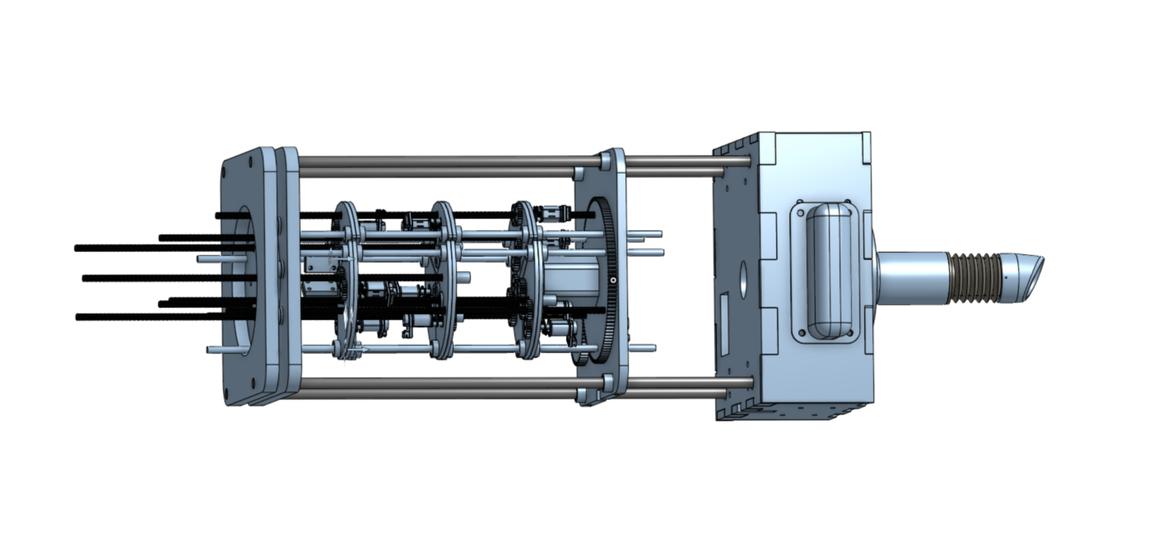
FASTR – Flexible Articulating Surgical Transoral Robot
26
Abstract
Transoral Robotic Surgery (TORS) has emerged as a promising minimally invasive approach for the treatment and removal of laryngeal tumors and lesions, offering enhanced precision and reduced clinician fatigue. Currently, the Da Vinci Single Port Surgical System is the only commercially available and FDA approved robotic system for TORS. However, the high cost, and induced remote center of motion limit the widespread adoption of the Da Vinci system. The system aims to perform TORS in the glottis region of the larynx where the workspace is constrained, and the surgical tools need to be inserted orally. This approach provides easier access by not requiring a linear insertion path for surgical tools to reach the desired location. In this paper, we present a novel robotic system for TORS that is more cost effective and less invasive than the Da Vinci system. The proposed system consists of two sub-systems: a 3-DOF robot consisting of two cylindrical tubes connected by a cable-driven flexible joint, and concentric tube continuum robots that sit inside the tubes of the 3-DOF robot. The 3-DOF robot is used to position the concentric tube continuum robots in the desired surgical workspace while the concentric tube continuum robots hold the surgical tools and provide the necessary dexterity for the surgical procedure.
27
HURON: Full-sized Humanoid Robot (Lower Body)
Team Members
Thai Duc Doan
Sahen Juneja
Nhi Nguyen
Carlos Giralt Ortiz
Advisors
Mahdi Agheli
Berk Calli
Markus Nemitz
Nitin Sanket
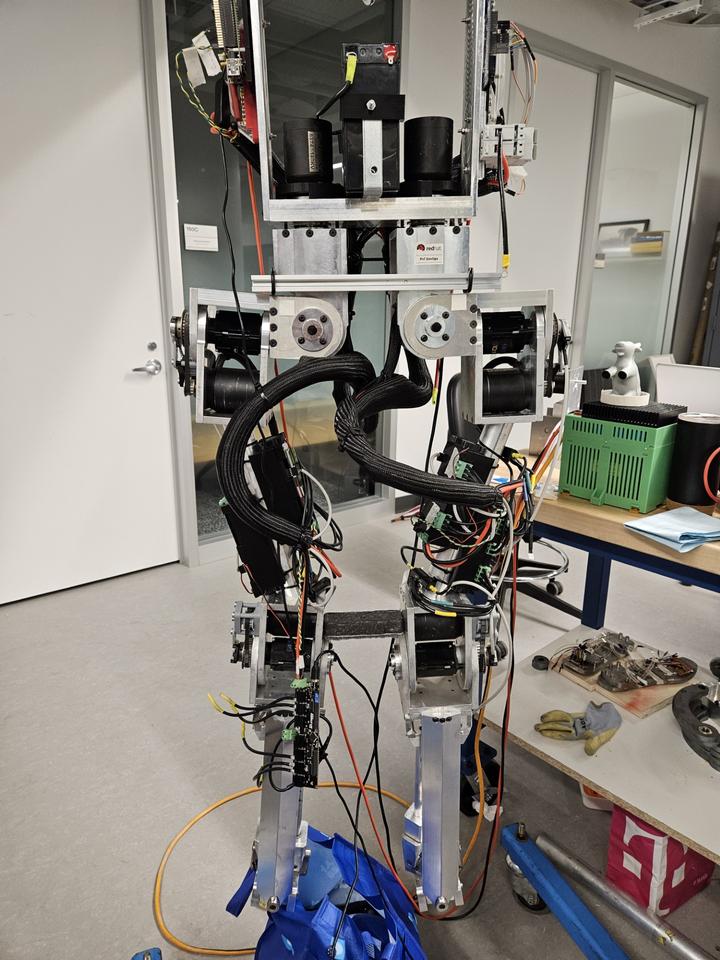
28
Abstract
This project builds on last year's HURON MQP, which successfully manufactured the majority of the lower body of the HURON humanoid robot. This year, we focus on improving the ankle design, building a solid open-source software platform capable of supporting any high-level research in bipedal and humanoid locomotion on HURON, and verifying our push recovery algorithm on the hardware.
29
Intracardiac Catheter Steering
Team Members
Megan DeSanty
Isabelle Lachaux
Elizabeth Minor
Rebecca Young
Advisors
Haichong Zhang
Shang Gao
Zhenglun Wei
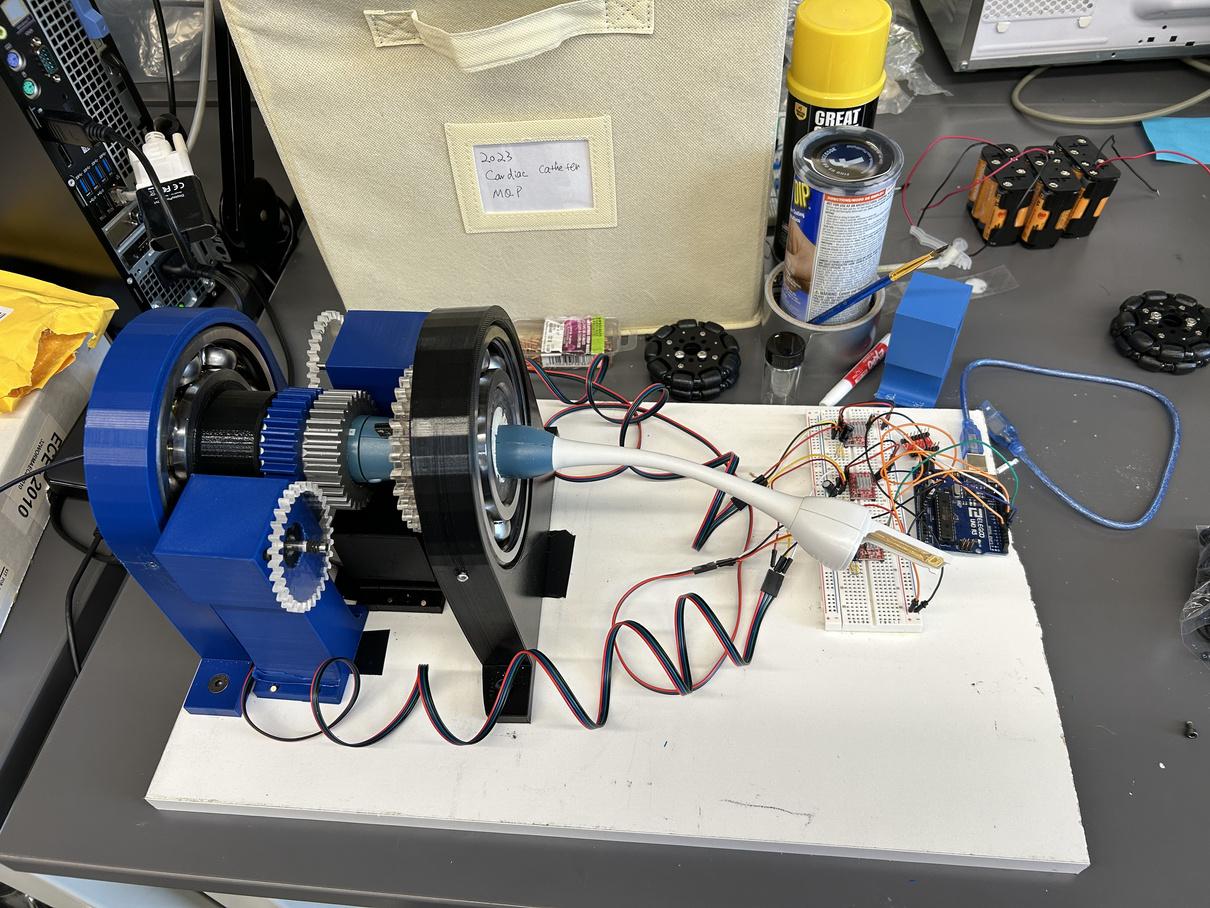
Loris Fichera
Yihao Zheng
30
Abstract
This project aimed to reduce clinician involvement in navigating an intracardiac catheter by developing an autonomous robotic steering system. Currently, mechanically driven intracardiac catheter procedures require 2-6 hours of precise and exhausting work for a clinician. In developing this system, the team intended to alleviate the strain on clinicians, allowing them to focus on tasks that require their expertise. The robotic device encases the ICE (Intracardiac Echocardiography) catheter, and actuates the internal pull-wires using teleoperated keyboard input from the physician. This input is sent as an Arduino command to the stepper motors, which rotate the catheter knobs to provide the rotational and translational movement of the catheter tip. This movement is displayed in a real-time simulation so a clinician is able to see where the catheter is moving at all times. By providing precise control and real-time feedback, the team hopes clinicians are able to focus on more critical tasks.
31
LEMUR: Learning and Education of Machine Learning for Undergraduate Robotics
Team Members
Tuomas Pyorre
Ashe Andrews
Andrew McKeen
Advisors
Greg Lewin
Kevin Leahy
Matt Ahrens
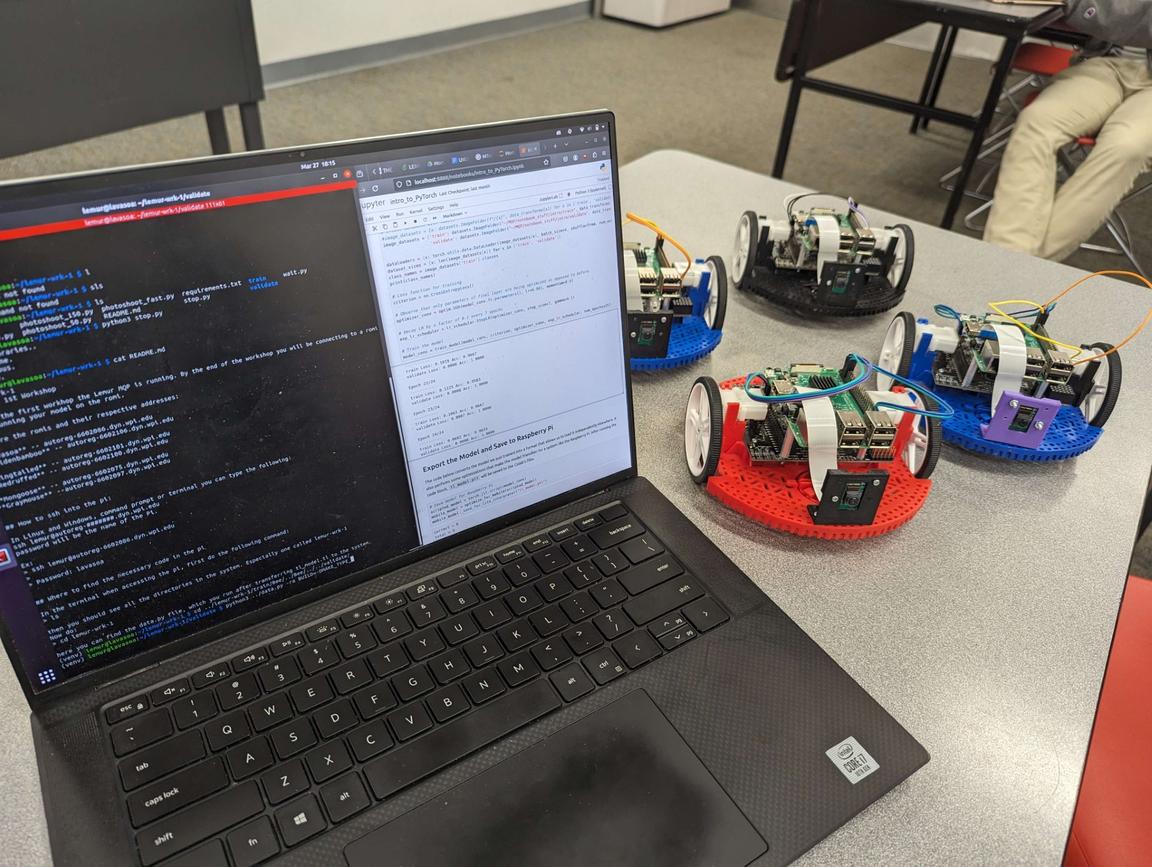
Abstract
Despite an undergraduate curriculum focused on in-demand robotics topics, WPI does not offer sufficient courses for students to learn about machine learning (ML) in relation to robotics. We developed educational modules where students apply ML theory, including transfer learning, optimization techniques, and reinforcement learning to robotic systems to develop potential course material. The modules were modified into workshops for testing with students. We evaluated the modules' effectiveness by comparing students' perceived confidence and ability in select topics before and after completing a workshop. After completion, students felt more confident in their understanding of higher-level concepts in ML, but still required support to apply them.
33
Modular Hybrid Flux Motor Development for High Torque Robotics Applications
Team Members Advisors
Adam Blanchard
Kaeden Berry
Arturo Lemos
Andre Rosendo
Yarkin Doroz
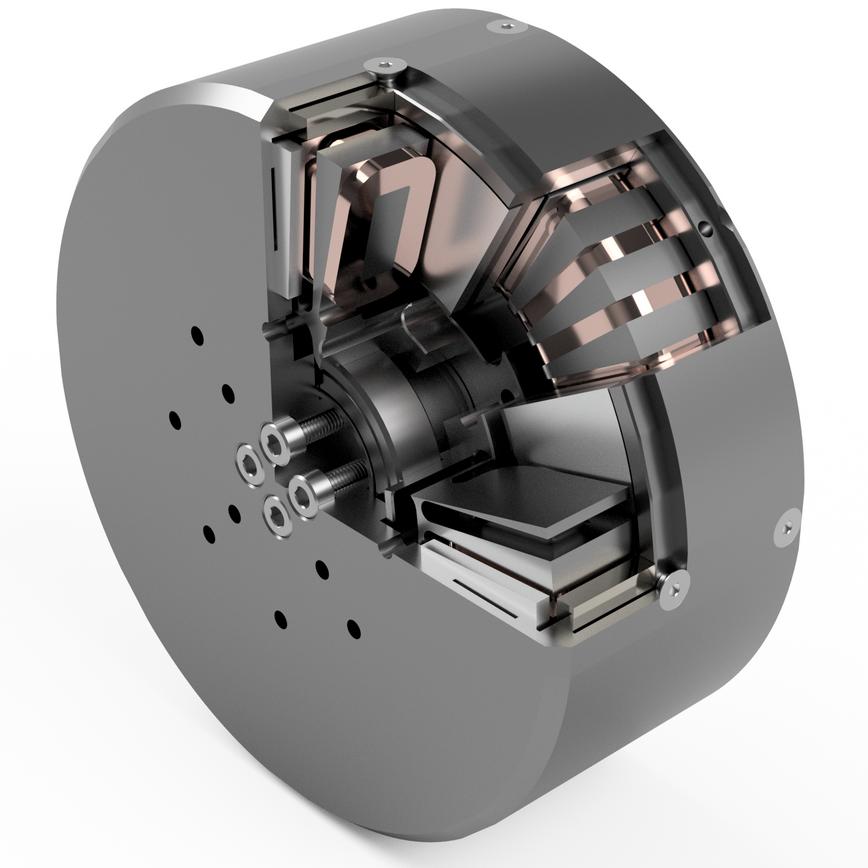
34
Abstract
Motors in many high-performance robotics applications must provide high torque outputs at low duty cycles. A higher torque motor enables a more responsive actuator under load by reducing or eliminating the gear reduction in series with the motor. Due to the low duty cycle, the limiting factor in the torque output of motors in these applications is more often the magnetic saturation of the stator iron rather than the thermal properties of the motor. In this work, the authors provide a unique approach to torque optimization for this application, describe the process of designing, manufacturing, and testing a novel modular hybrid flux motor following these principles, and provide analysis and data on the torque performance of the resulting motor when compared to several common configurations.
35
Multi-Robot Persistent Coverage Under Fuel and Stochastic Failure Constraints
36
Team Members Advisor Yaşar İdikut, Camden Cummings, Samara Holmes Carlo Pinciroli
The guiding application of this research project is multi-robot systems as they relate to agricultural challenges, especially in the persistent inspection of cropland. In this research project, we present both a baseline (MILP) and novel algorithms to solve a multi-robot coverage problem under battery depletion and stochastic failures. We compare the solutions based on metrics about visitation and redundancy. Finally, we present a visualization, a simulation, and a real-world demonstration (using Khepera IV robots) setup to provide additional data to analyze our solution.
37
Abstract
NASA Lunabotics
Team Members Advisors
Zeb Carty
Kelli Huang
Ian MacInerney
James Nguyen
Terence Tan
Sean Thal
Giovanni Giacalone
Brendan Byrne
Ken Stafford

Carlo Pinciroli
38
Abstract
The NASA Lunabotics competition is a robotics competition that allows teams from across the country to design and build a lunar mining robot. Teams can prove their engineering skills by showcasing a robot with the ability to navigate simulated lunar terrain, collect regolith, and construct a berm on the regolith surface. With new competition rules this year, the WPI Lunabotics Team designed and manufactured Muffin. A lightweight, agile, and autonomous robot, Muffin takes inspiration from successful robots at past Lunabotics competitions. The project also allowed the team to develop invaluable engineering skills they will use throughout their careers. Using these skills, the team developed innovative subsystems to meet the challenges of the competition.
39
Progressive Molding of Soft Robots for Ocean Conservation
Sara Frunzi
Dilce Oliveira
Owen Rouse
Markus Nemitz
Cem Aygül
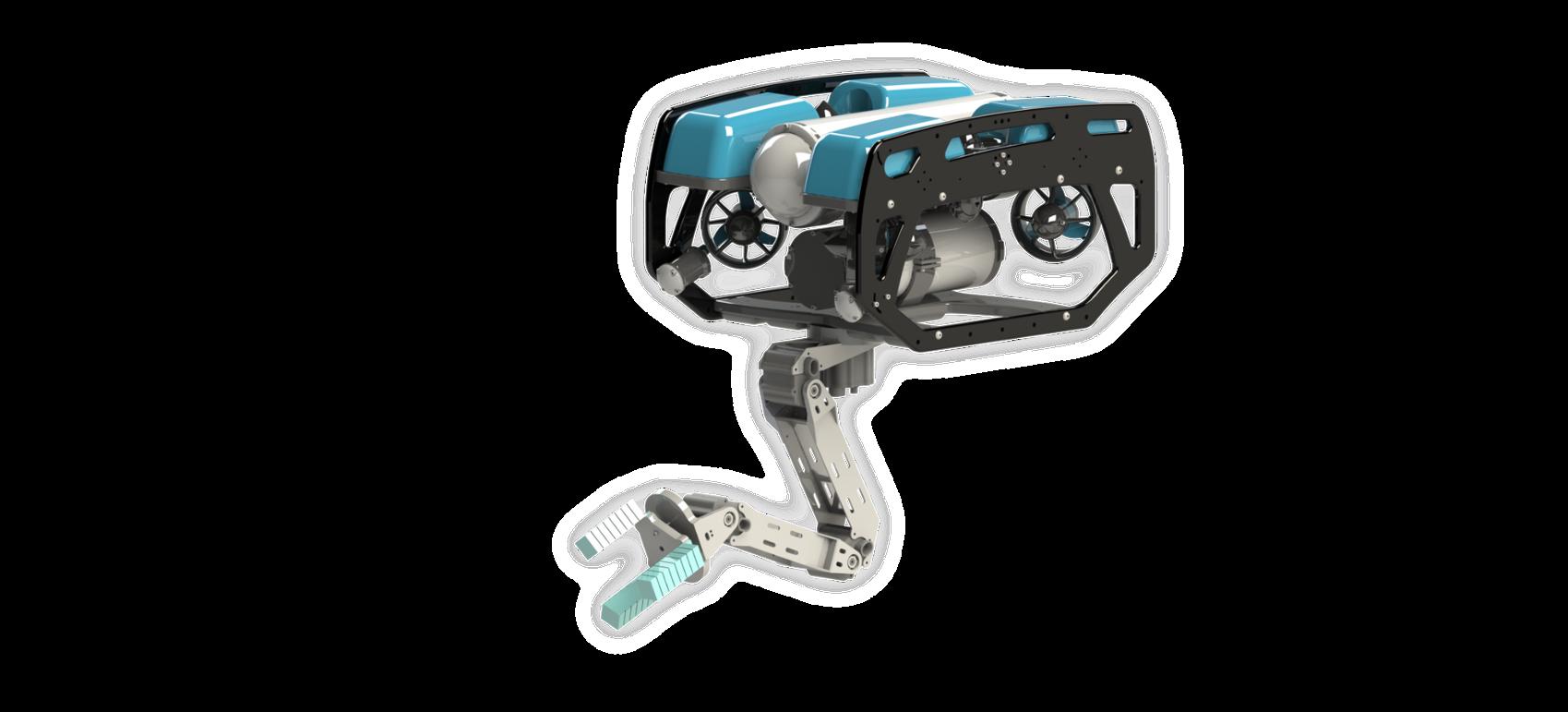 Team Members Advisors
Team Members Advisors
40
Abstract
Coral reefs, which house a quarter of the ocean’s biodiversity, are under threat due to plastic waste. Underwater remotely operated vehicles (ROVs) equipped with a gripper can be used to collect macroplastics caught in the reefs. Due to the frail nature of coral, these expeditions require sensitive manipulation; grippers made from soft rubbers and plastics allow for manipulation with minimal risk to the surrounding environment. However, fabrication of these grippers is often complex, time-consuming, and necessitates manual labor. We present a novel fabrication technique progressive molding to streamline the process of creating soft gripper components. By using this method, we can create complex shapes that cannot be made in a single cycle of replica molding while using materials that are too soft to be 3D printed. We design a soft gripper with actuators that can be fabricated via progressive molding. Then, we attach the gripper to a four degree-of-freedom robotic arm on a commercially available ROV to remotely clean coral reef systems. Finally, we tested our system in the WPI pool by removing macroplastics from 3D printed coral models.
41
Sailbot
Team Members Advisors
Mathew Gomes
Erin Murphey
Anthony Virone
Theodore Winter
Kenneth Stafford
William Michalson
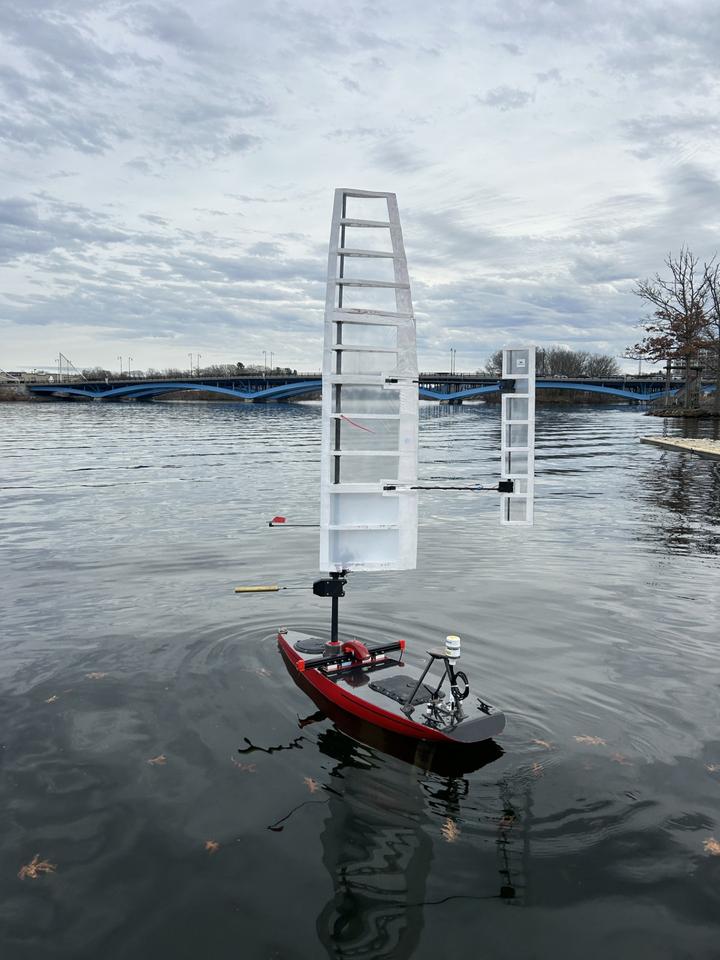
42
Abstract
SailBot is an autonomous robotic sailboat created to compete in the International Robotic Sailing Regatta. This year’s SailBot focused on designing and manufacturing and expanding software systems. This hull was manufactured to improve water flow around the hull and increase accessibility in the SailBot for maintenance. The software systems developed focused on communications reliability, failure recovery, and autonomous functionality. Additionally, the boat's electrical system was redesigned to ensure greater platform stability and longevity.
43
Social Robot for Interactive Play
Joseph Baliestiero
Jayson Caissie
Kaley Du
Megan Jacques
Chloe Plasse K. (V) Valery
Team Members Advisors
Jane Li
Rose Bohrer

44
Social robots, which are autonomous robots with the ability to connect and communicate with humans, have become prominent in the medical and educational fields, and have even become artificial companions for people in their homes. Within the medical and educational field, social robots are used to help teach emotional and behavioral skills and help with emotional regulation. Social robots have also become commercially available, such as Jibo; a consumer-oriented robot that forms a relationship with the person or family that “adopts” it. The social robot we have developed, named Tavi, aims to connect with the person who is interacting with them via a 20-questions style game. The robot has a personality that coordinates the ear positions, arm positions, and facial expressions to convey different emotions to the user. Tavi also has facial tracking to center on the user’s face and uses a game loop to interact with the user. The game is accessible via an application that communicates with the robot, and the robot responds accordingly. Tavi is constructed mostly out of PLA and was 3D modeled using SOLIDWORKS. Tavi’s software utilizes ROS, C++, and Python to communicate with all the technology within the bot.
45
Abstract
Soft Assistive Robotics for Helping Daily Tasks
Team Members Advisors
Luis Aldarondo
Antonios Sevastos
Ethan Weisse
Hannah Zink Berk Calli Loris Fichera Cagdas Onal
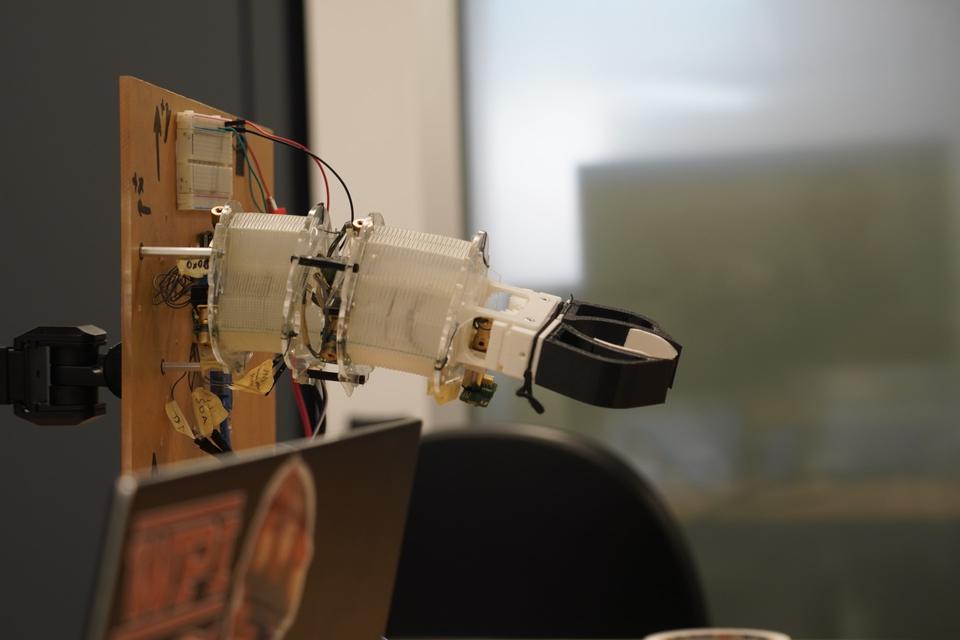
46
Abstract
This project focuses on creating a soft assistive robotic arm with a user-friendly interface to help people who use wheelchairs with daily tasks. This year our team created a model of this system by modifying existing origami modules, designing a soft robotic gripper, and creating a control system which integrates user inputs with sensor data to easily manipulate common household items. Soft robotics is a growing field of research. These robots offer the flexibility and adaptability that traditional rigid robotics lack, making them safer for interacting with humans and other delicate environments. This project looks at how soft robots are applicable for assistive technologies. Wheelchairs, which are used by over 3.3 million Americans, are typically used for mobility related disabilities, which often affects overall motor skills making daily tasks significantly more difficult. This design would provide greater independence to people who use wheelchairs worldwide.
47
SOPHT: Soft Prosthetic Hand
Christina Aube
Jeff Davis
James Doucette
 Team Members Advisors
Mahdi Agheli
Markus Nemitz
Team Members Advisors
Mahdi Agheli
Markus Nemitz
48
Haichong Zhang
Abstract
The SOPHT project consists of a soft-layered, cable-actuated robotic hand combined with a motored-controlled arm that is anatomically proportional and accurately represents the dexterity of human capabilities. Arm functionality is demonstrated via various arm gestures and mimicking American Sign Language (ASL) gestures.
49
Symbiotic Multi-Agent Construction 5.0
Team Members
Genna Brown
Edward Enyedy
Can Güven
Isa Kaplan
Cambria
Pomeranz
Isabella Rosenstein
Advisors
Greg Lewin
Carlo Pinciroli
Markus Nemitz
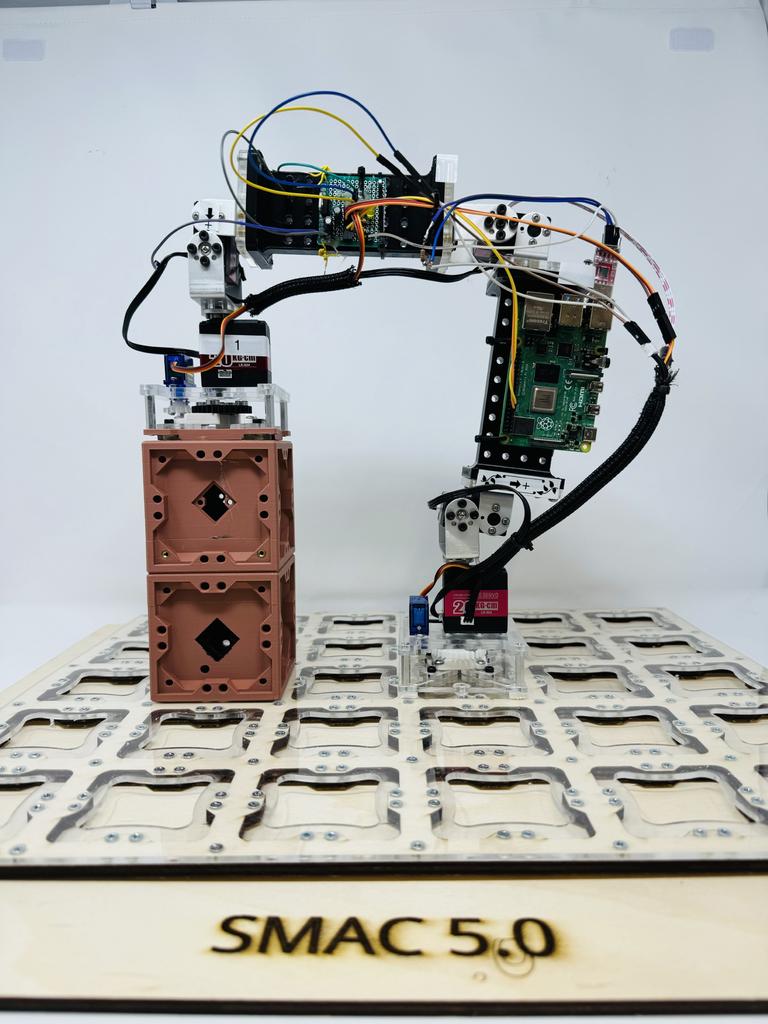
50
Abstract
Robotic collective construction is an approach to automated construction that enhances safety and efficiency in the construction industry. Inspired by the observed behavior of insects, in which the construction environment acts as a shared memory for workers, this project features two types of robots: “smart” building blocks capable of storing and sending data and inchworm-inspired builder robots that navigate and modify the 3D structure. Built upon the concepts established by past iterations of this project, SMAC 5.0 improved the hardware and software design of the inchworm and the blocks, yielding a research tool for further exploration of the algorithms essential to coordinate a decentralized swarm of inchworm builders.
51
Trashbot: Autonomous
Trach Collecting Robot
Team Members
Matthew Sweeney
Cristobal R Rogers
Liliana Loughlin
Yuhan Wu
Advisors
Andre Rosendo
Fabricio Murai
Neil Rosenberg
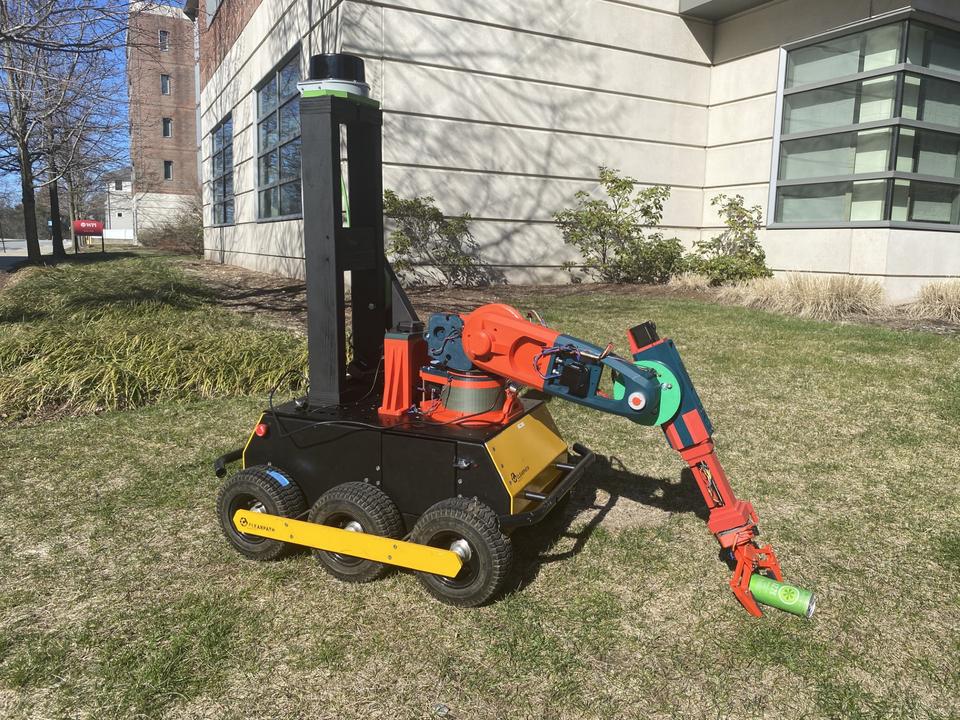
52
Abstract
Pollution poses a significant challenge in our modern world, with humans generating vast amounts of plastic waste that endangers the environment and its wildlife. Currently, addressing this issue relies heavily on human interventions, such as clean-up efforts on roads and beaches. Unfortunately, these are typically inconsistent and unreliable. To tackle this problem, the Trashbot Major Qualifying Project at Worcester Polytechnic Institute is developing a prototype robot for the autonomous collection of plastic bottles and aluminum cans. This innovative project aims to create a robot that can navigate WPI's quadrangle independently, detect litter, approach it, collect it, and dispose of it in a designated location. The Trashbot project is a groundbreaking initiative, marking the beginning of a multiyear interdisciplinary endeavor. In the initial phase of the project, the team has achieved several milestones. They have enabled the robot to autonomously navigate using a GPS module and Inertial Measurement Unit, detect trash using a depth camera, and pass raw images to a trained object detection and classification AI model, YOLO. Additionally, the team has designed and fabricated a 4-degree-of-freedom articulated manipulator, implemented a path planning algorithm using a graph state model and installed a LiDAR fixture for future enhancements.
53
Underwater Filmography Using Robots
Riley Blair
Christopher Chow
Gabriel Demanche
Olivia Simon
Markus Nemitz
Carlo Pinciroli

Jeanine Denu
Dudle
Team Members Advisors
54
Abstract
Since its inception, cinema has utilized cutting edge technologies to bring invigorating entertainment to the masses. Despite being at the forefront of innovation, cinematographers are still limited by underwater videographers to bring their creative visions to life. After meeting with an accomplished director to define industry challenges and standards, this project utilized robotic technologies to develop an ROV capable of overcoming the unique conditions of underwater environments. Our developed product meets directors needs by safely housing a RED Komodo cinema camera while providing stable motion and framing in all 6 degrees of freedom. This harmony of robotics and cinematography introduces a novel method for underwater filmography, creating new and exciting possibilities for directors and filmmakers.
55
Voice Control of the HOPE Hand Exoskeleton for Individuals with Motor Impairments and Speech
Aphasia
Team Members
Connor Gaudette
Matt McGourty
Keenan
Segenchuk
Allison Rozear
Advisors
Christopher Nycz
Yunus Doğan Telliel
Haichong Zhang
Tess Meier
Erin Solovey
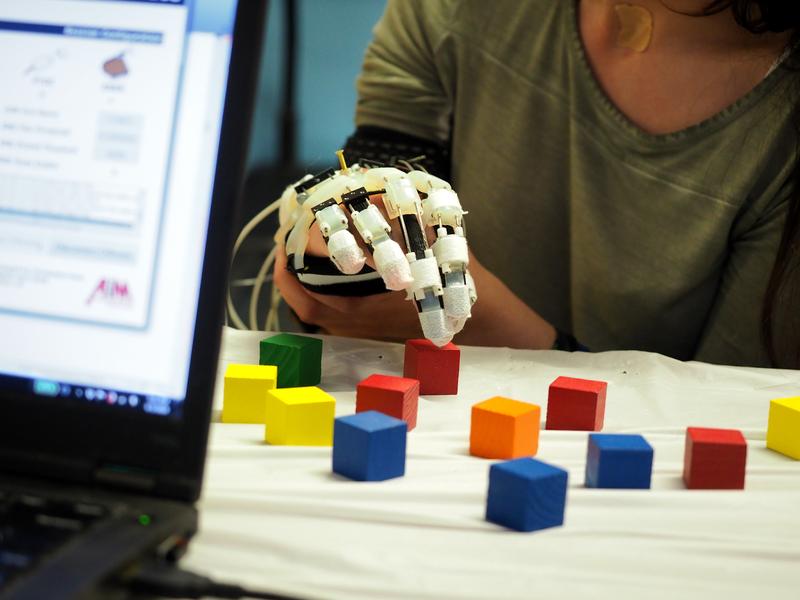
56
Abstract
The HOPE Hand exoskeleton is a motor aid for people with hypertonicity and spasticity. This project develops a voice control system for the HOPE Hand which is trained for the types of speech aphasia that often impact this patient population. Vocalizations of typical and aphasic speech were collected and used in conjunction with open source datasets for training. Existing AI models were modified and trained on these data to identify users and recognize commands, then integrated with the HOPE Hand.
57
Waste Sorting Robot for Recycling
Team Members Advisors
Valerie Childers
Brett Cohen Dylan
Hunt Nicholas Moy
Isaac Noble
Gabriel Ward
Lily Wolf
Berk Calli
Sarah WodinSchwartz

58
Abstract
With the continuous increase of yearly global waste, recycling has become an essential initiative. Despite this, issues of efficiency and profitability continue to mar efforts to expand its reach. Robotic systems offer a chance to improve and automate inadequate waste sorting processes, with recycling especially standing to benefit. This MQP represents one such solution: A conveyor belt and gantry system, designed for interchangeable end effectors, intended to operate continuously, with minimal human input by utilizing machine learning object detection.
59




















 Team Members Advisors
Team Members Advisors



 Team Members Advisors
Mahdi Agheli
Markus Nemitz
Team Members Advisors
Mahdi Agheli
Markus Nemitz





